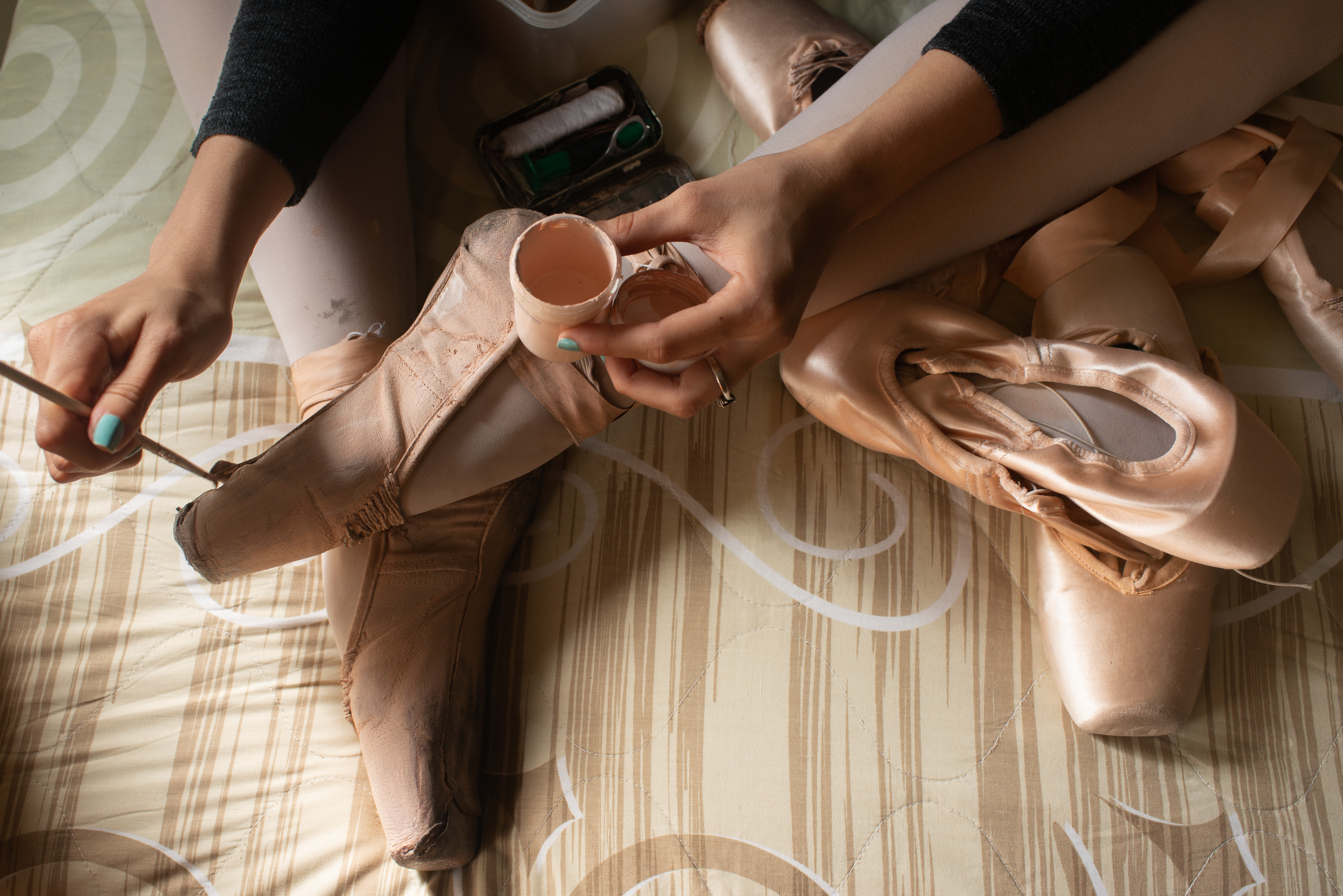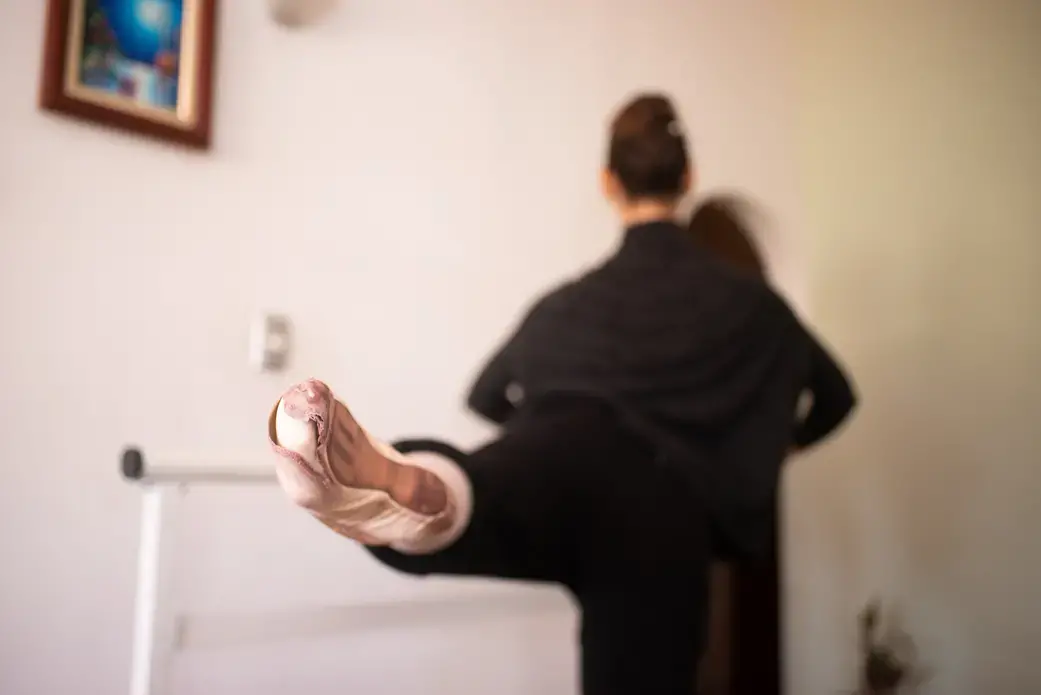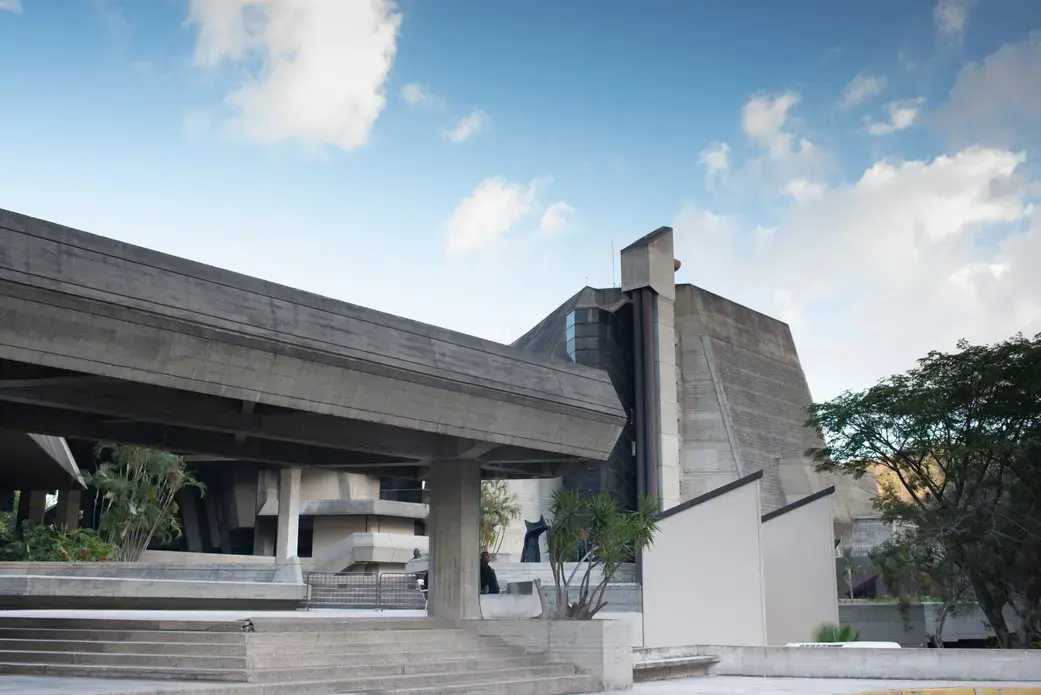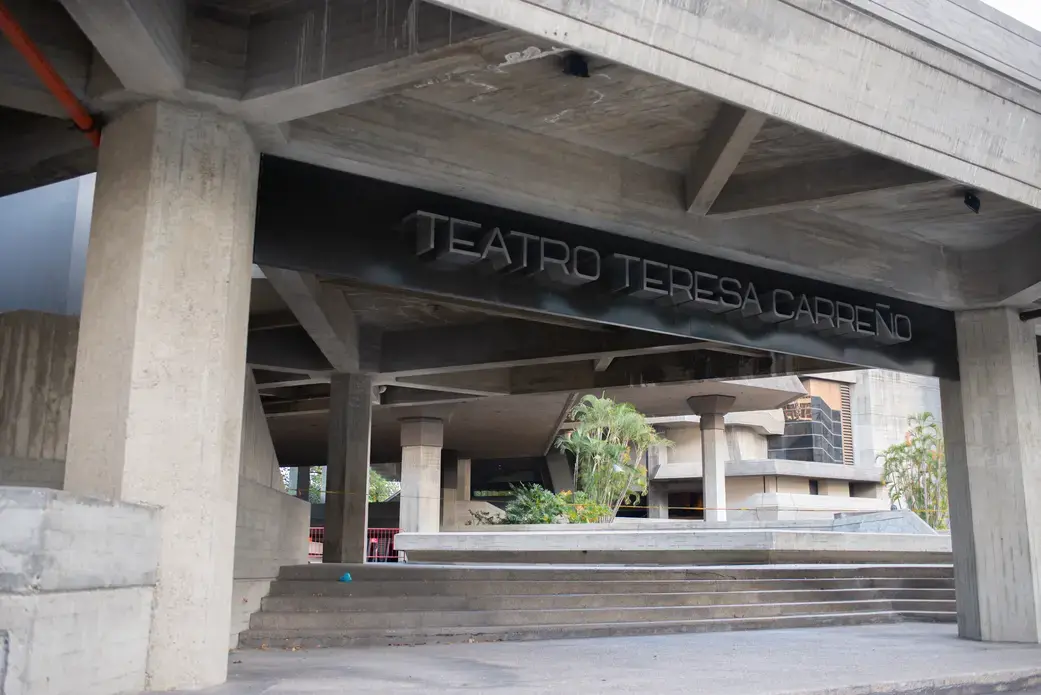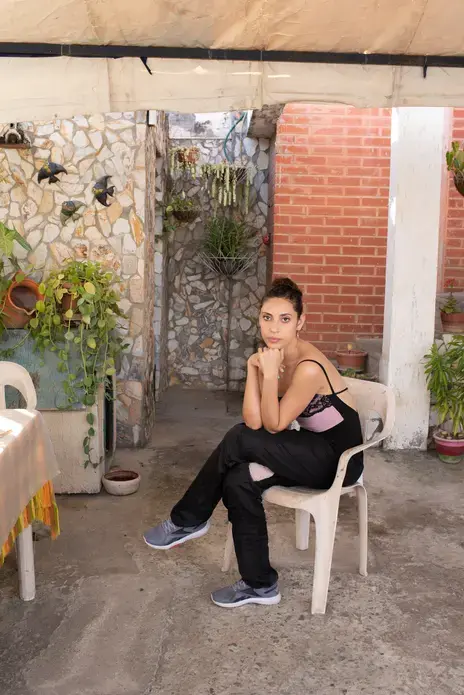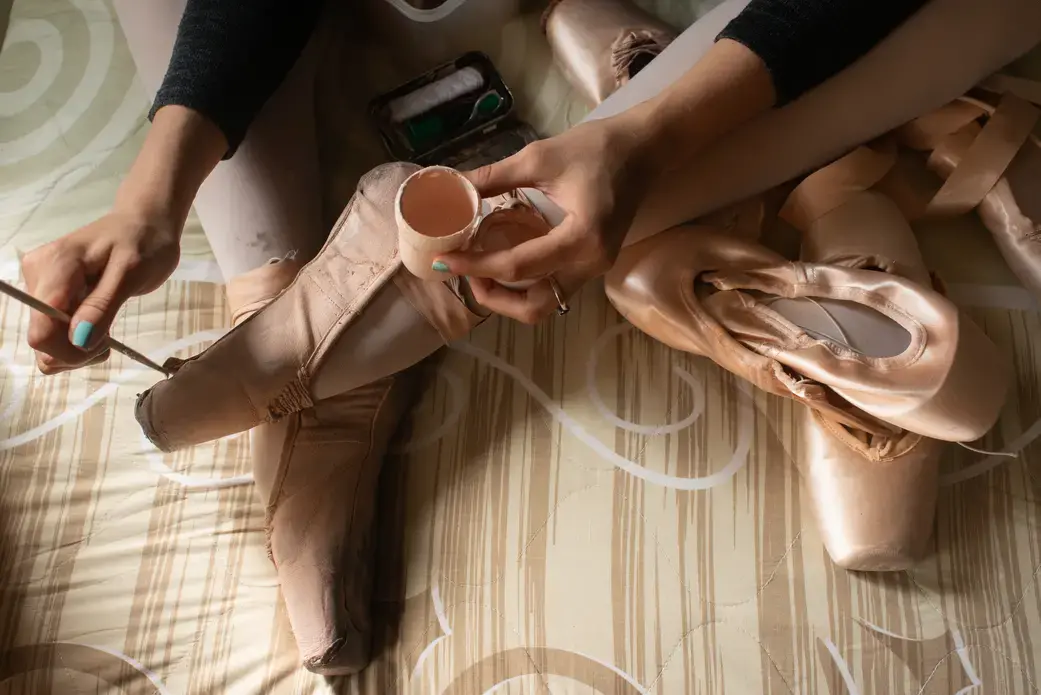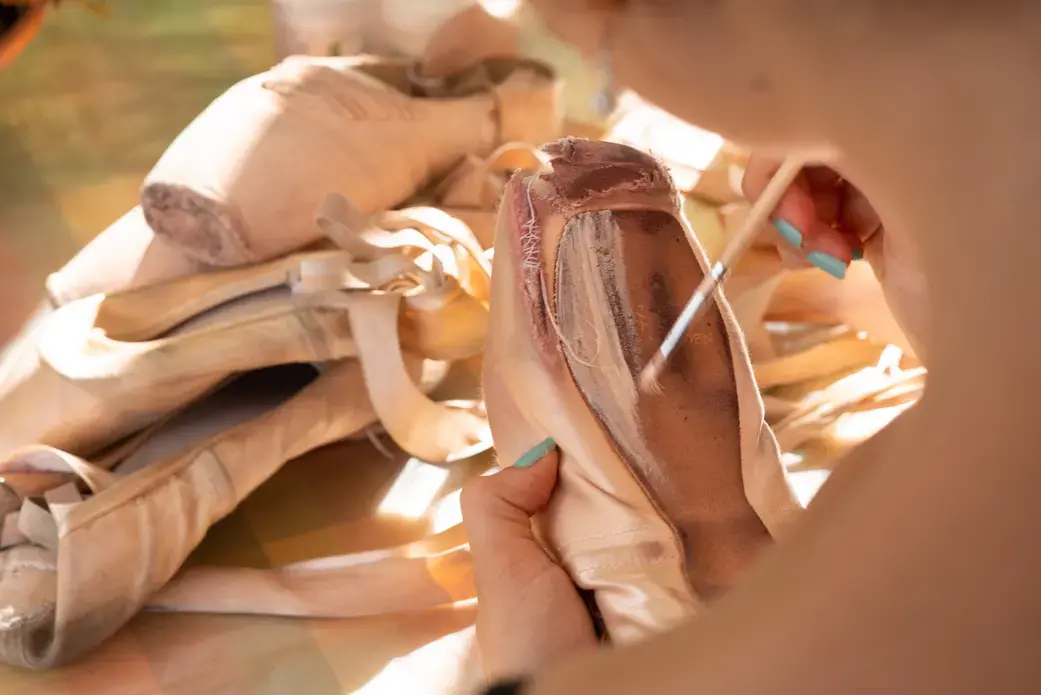Antonella Cerquone, a 19-year-old aspiring ballerina, takes her pointe shoes out of her backpack as soon as she gets home from class. She places a worn-out pair of Gaynor Minden’s on the ground and prepares to paint them. After several coats of paint, with emphasis on the arch, she leaves them in her backyard to dry out for two days. Cerquone has been wearing the same pair of pointe shoes for more than a year, doing this and other house tricks to extend the life of a shoe that was built to expire after 20 hours of use.
On average, a ballerina goes through 120 pairs of pointe shoes over the course of a 40-week season. However, dancers at Ballet Teresa Carreño (BTC) in Caracas, Venezuela, only receive a few pairs each year and have to rely on artisanal methods to keep their shoes strong and their feet on pointe.
Shoes are but one of the many challenges facing BTC dancers. Astrid Arvelo, a lead soloist with the company, takes her Gaynor Minden’s (the only brand provided for the dancers) to a shoemaker and waits up to three weeks to get them fixed. “In the meantime, I paint them, sew them and put glue on to keep them strong, but most of the time it’s not enough,” she said.
As a fundamental tool for a ballerina, dancers strive for comfort and security in their shoes. A shoe that is softer than intended can cause serious damage to their bodies. Veronica Rojas, a former ballerina, said she would also get sizes from BTC that were originally intended for other ballerinas. She later developed plantar fasciitis as a result of wearing expired shoes. “There was a point I could not even walk and I had to do a lot of therapy to recover. I have hyperextension on my arch. You combine that with soft pointe shoes and everything goes wrong.”
BTC is the last ballet company remaining in the country, a hallowed institution that was already on its last legs due to politicization, lack of resources, absence of artistic direction, and now the COVID-19 pandemic.
The absence of an artistic director sits at the core of BTC’s challenges. Without a clear direction, the company is fading from the international dance scene due to totalitarian government control. After being a leader in contemporary practices and innovation during the 1980s and 1990s in Latin America, it now faces an uncertain future.
Taking Over Cultural Institutions
BTC lives inside one of the biggest cultural complexes in Latin America, Teatro Teresa Carreño, a theater where the National Opera and Orchestra are also based.
In 2001, President Hugo Chavez started what he called a “cultural revolution” by firing the directors of art museums, galleries, and theaters on national television because they were not in alignment with the revolutionary vision. It was the first time in Venezuelan history that a head of state had intervened in art institutions.
The famous choreographer and BTC artistic director Vicente Nebrada died the following year, in 2002. Subsequently, the executive positions at Teatro Teresa Carreño were filled by politicians.
Just 10 years ago, three other companies enriched the ballet scene. There was a time when one could choose where to develop a dance career in Caracas: Ballet Nuevo Mundo de Caracas (1981- 2015), Ballet Contemporáneo de Caracas (1992-2010), Ballet Metropolitano de Caracas (1968- 2014), to name a few. Now, young dancers face a sobering decision—either stay and hope BTC can be restored to its former glory, or leave the country to seek out better and more stable opportunities.
To Laura Fiorucci, former assistant director of BTC, the roots of its decay stem back 20 years. In 2003, president Chávez selected Jose Luis Pacheco, a civil engineer and politician, as director of Teatro Teresa Carreño. Under Pacheco, the company would perform exclusively classical ballet. According to Fiourucci, at least four people who opposed the idea were fired. “I tried to explain that classical exclusive companies were obsolete and that the company should show diversity,” she said. Fiorucci was later dismissed due to her objection.
A decade later, in 2013, Nicolas Maduro became president, and by the end of the year he had ordered, by presidential decree, the reorganization of Teatro Teresa Carreño. The resolution sought to bring order out of chaos. The main directors were fired, and the institution was left in the hands of an intervening board led by Gustavo Arreaza, composer of the Venezuelan Socialist Party’s (PSUV) anthem and brother of then-Vice President Jorge Arreaza. An action that was meant to last six months has continued for seven years and although some of its original members have changed, Gustavo Arreaza continues to serve as the president of the theater and BTC remains without an artistic director.
Instead, the ballet operates under a ballet coordinating team, composed of one coordinator, one secretary, two rehearsal supervisors, one company teacher, and two dancers who are aspiring choreographers. The current coordinator's responsibility is to provide dancers with water and shoes, make sure the floors are clean, and do anything else that dancers might need. However, due to the administration’s negligence, the conditions for dancers did not improve. Instead, they were rapidly declining.
Propaganda Over Art
The cultural complex has been used to spread propaganda in different ways—from hanging portraits of socialist leaders, using the spaces as a market, or providing bags of food known as Comite Local de Abastecimiento y Producción (CLAP), to staging ballets with political content.
In 2014, BTC came into the international spotlight after the premiere of “El Arañero” (“From Spider Seller to Liberator”), which narrates the story of of Hugo Chávez’s life. While it’s composed of three acts, the final act shows Chávez heroically defeating North American imperialism.
Government leaders would also come to the theater to broadcast their programs or speeches without previous notice, consistently interfering with the BTC schedule.
“They would deny us entry to the theater because it was being used for political activities," recalled Rojas, former BTC dancer. "There was one time when I arrived with Astrid and they did not want to let us in, but I talked to someone who finally allowed us to enter. However, a couple of minutes later they stopped us, took our IDs, and threatened to incarcerate us.”
On other days, the cultural complex was used as a major grocery store, and artistic activities would be canceled. Rojas recalled that “on Saturdays, they would sell fish or deliver the CLAP boxes” and that it was publicized as a benefit for the theater’s employees. “I should be able to go buy all the groceries I need from any store. The theater is not the place to do it.”
Dancers who spoke out or protested about the situation were punished. Michael Requena, another former member of BTC and current dancer with Ballet del Teatro San Martín in Buenos Aires, expressed feeling disrespected by the directors. Company classes and rehearsals were being canceled if they conflicted with political events. If dancers didn’t attend these events, they faced reprisals. “I was called to the board’s office a couple of times," Requena said. "At the beginning they didn’t give any admonition of any sort. However, they would let me know they were aware of me not attending the events, which led to frictions. Later on, I started to dance less and was not taken into consideration to play certain roles.”
Arvelo said she prefers to keep her distance. “I have played blind, deaf, and [I] keep quiet. If anyone says something I just step aside.”
Many dancers have left the company, some have retired, and others have sought international opportunities to fulfill their dreams. “I was feeling forced and attacked… I think that to be able to work at the BTC you have to shut up and do as they said, but there is something inside of that, a sense of morality and respect to our art form that forbids us to do it,” Requena added.
Operational Breakdown
Sala Ríos Reyna is the main hall of BTC for company performances, where many Venezuelan dancers have dreamed of stepping foot. The room had to close in 2018 due to AC malfunctions. Insect infestations in the locker room were frequent. These are some of the conditions that plagued those who danced in BTC.
“We also used the basement," Arvelo said. "We did performances in what we call Realization Workshops. We would use a platform of the stage that is stored in the basement and had the audience come downstairs to watch us dance. We also performed small pieces outside the theater. But we always did The Nutcracker in Sala Ríos Reyna, despite the AC malfunction.”
These operational problems extended throughout the entire cultural complex. Lightbulbs were either broken or stolen. Dancers had to bring searchlights to Sala H (the company's main studio), but could not illuminate the room properly and, according to Arvelo, it represented a problem for dancers while practicing and performing. The escalators stopped working and there were reports of holes in Sala Beracasa that dancers had to cover with a barre.
Dancers complained about the sanitation of the spaces. Dressing rooms were infested with cockroaches. “You could see them crawling on top of the dancer’s towels. One day we opened the lockers from the dancers who had left years ago and the back of it was covered with cockroaches.” Dancers had to buy cleaning supplies themselves and fumigate the place.
Beatriz Márquez, another former ballerina, stated that the uncertainty experienced in the theater led her to retire, noting personal differences with the theater management. “We already had about four years with this intervention and everything began to dull. Internally we were not rehearsing anything, we had no repertoire. There was one year that the only thing we danced was The Nutcracker,” she said. “I did not want to continue to be a part of an institution that was in such a condition—although Teresa Carreño is the love of my life, it’s where I always wanted to be and where I developed the most important part of my career.”
A Rudderless Ballet
Márquez argued that a plan should be elaborated to provide the dancers with the tools they needed, starting with the designation of an artistic director. “The training dancers receive should be associated with their performance schedule, and during all the years I worked there I never experienced that. So, you realized at the end of the year that you are physically exhausted and still have several shows of The Nutcracker ahead. There is no one who sets the tone or can choose a repertoire. If you look at other companies you can find their schedule years in advance.”
Márquez also complained about the lack of investment in new pieces for the company to present. According to her, proposals for investing in international repertoire were made several times, but not even the national repertoire was being considered. “We were mostly dancing rights-free pieces. It is complicated because you cannot help but wonder where your career is going or if you’re ever going to have the chance to perform certain roles. In the end, we as dancers have our own personal goals.”
Insult to Injury
In 2020, the pandemic pushed the professional ballet scene into a darker spot. “Everything is uncertain," Arvelo said. "We have been going through difficult times and we are basically doing the same thing we were doing before COVID-19 but without in-person classes or rehearsals. There is a long and rough road ahead of us to recover the time we had lost."
As a lead soloist who dreamed about her professional dance career ever since she was a little girl, Arvelo believes that it’s natural for dancers to move around and seek out opportunities, but it’s unnatural for a place such as BTC to force so many talented dancers away and out of the country.
Despite the number of dancers who have decided to leave to pursue their professional careers elsewhere, those who stayed are giving everything to remain motivated and optimistic, such as creating their own choreographies called Laboratorios Coreograficos.
Meanwhile, Antonella Cerquone, the aspiring young ballerina, has decided that her future is abroad, and she continues to seek international opportunities. But when looking at her photos on social media, the Venezuelan flag is often in the frame. One series of images shows Cerquone putting her pointe shoes on. When she goes out into the streets of Caracas, her pride in Venezuela is apparent. She takes a leap while holding the flag in her hands as tight as she can.
Author’s Notes: In the past weeks, photos of a rehabilitation process were published on the official Instagram account of the theater. A request for interviews was made and no answer was received. A local journalist sent on behalf of this reporter was denied entry to the theater. Teatro Teresa Carreño does not currently offer a schedule for a repertoire or a list of the ballet company employees and members, nor does it have a website available to the public.


